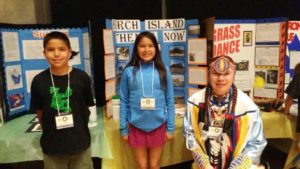Young leaders show projects at provincial Heritage Fair

By Barb Nahwegahbow
TORONTO—At six feet tall or thereabouts, 13-year-old Shade Kaiser, citizen of M’Chigeeng First Nation is a striking figure in his dance regalia. He was selected by Kenjgewin-Teg Educational Institute to be a delegate to the Ontario Provincial Heritage Fair in Toronto. Shade was joined by two other students, Eli Paibomsai and Avery Sutherland, both from Whitefish River First Nation.
The Ontario Provincial Heritage Fair brings together students from grades 4 to 10 for a non-competitive, interactive history camp. It includes a public showcase to promote awareness of Ontario and Canadian history and heritage. The showcase gives the student delegates the opportunity to share their research projects. This year, the camp and showcase was held at University of Toronto’s New College on June 11.
If you ask 11-year old Eli Paibomsai any question about nmebine, the sucker fish, chances are he will give you an answer. The research he did for his project has made him a bit of an expert on the sucker.
Visitors to his booth at the Heritage Fair are treated to all kinds of facts about this “highly undervalued freshwater fish, often being discarded as a garbage fish by anglers and gillnetters alike”.
At one time, the sucker was such an important fish species to our people, Eli told a visitor, that the spring season was named after this species. “And did you know,” he continued, barely taking a breath, “that the sucker is part of the minnow family?”
His knowledge about the sucker came from the internet, books and talking to his father “who’s practically an Elder,” he said.
Eli prefers his sucker smoked and glazed with maple syrup, “but you could also just cut off the head and make a soup out of it,” he said.
“I love my community,” said eleven-year old Avery Sutherland. “I’m interested in what my community was like before my generation,” she said, “and the comparison between now and then.”
Her project, Birch Island Then and Now, was born and she sought out Elders who were willing to share their knowledge and experiences. Some even shared their old photos with her.
One of the things she learned is that, “I have more privileges than past generations”, she said. “Like I don’t have to do very many chores and I know at school, they’re not as strict. Our teachers, they’re very kind, they’re very friendly. And I know from talking to the Elders that it was very different when they were children. The teachers were strict, mean.”
Avery is in Grade 6, and when she is not doing historical research, she is running or playing basketball and baseball. She knows she would have more opportunities for sports in the city, “but I don’t want to move! I love my community.”
“I am proud of my culture,” says the personal statement on Shade Kaiser’s project, “and love to share my teachings.”
Shade, the grade 7 student who is of Anishinabe, Haudenosaunee and German descent, has been grass dancing since he started walking. He decided to do his Heritage Fair project on the Grass Dance, “because it’s just something that’s really close to me,” he said. “What I like about it,” he said, “it’s a healing dance. It helps people in tough times.”
Shade said he dances at all of the Pow Wows on Manitoulin Island. His project, colourful and eye-catching like his regalia, contains several photos of himself at Pow Wows with friends, tourists and fellow dancers.
He researched the origin and meaning of the Grass Dance on the internet and also by talking to other dancers. “Grass dancers are treated like scouts,” he says in his project, “they are sent in first at the beginning of a Pow Wow to bless the grounds before the Pow wow starts.”
Chief Shining Turtle, Whitefish River First Nation accompanied the three young people to Toronto. He had this to say: “Three First Nation youth participated in the Provincial Heritage Fair in Toronto. These brilliant students are reflecting history and heritage through their eyes. And judging by the quality of each presentation, their vision is crystal clear and their resolve is absolute in offering an Indigenous view of what is our shared history.”
“…man is a bundle of relations, a knot of roots,
whose flower and fruitage is the world…”


